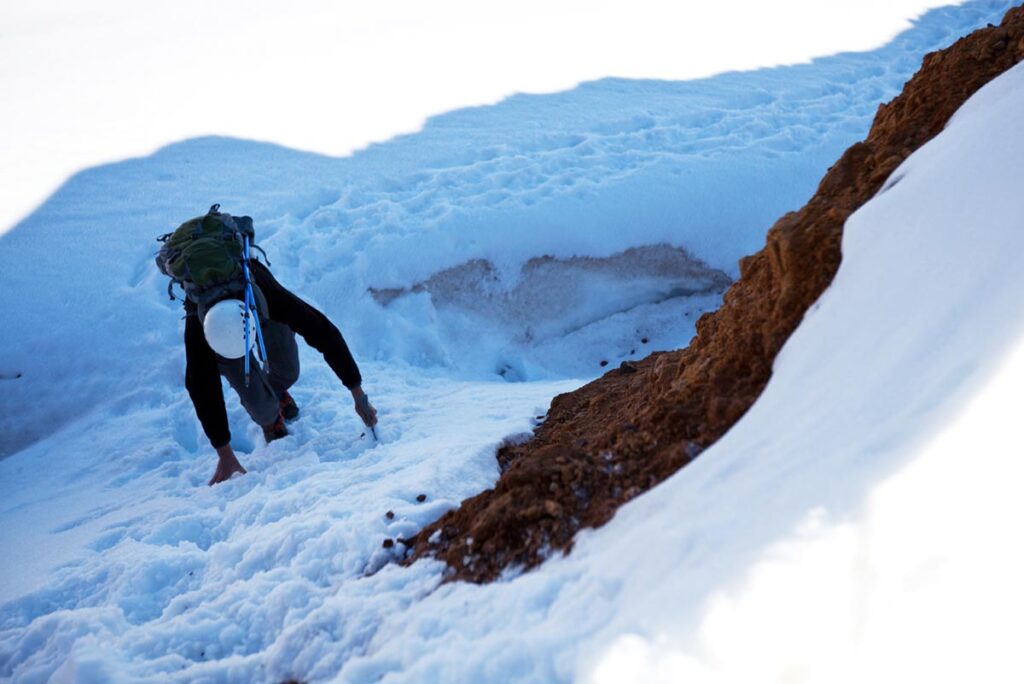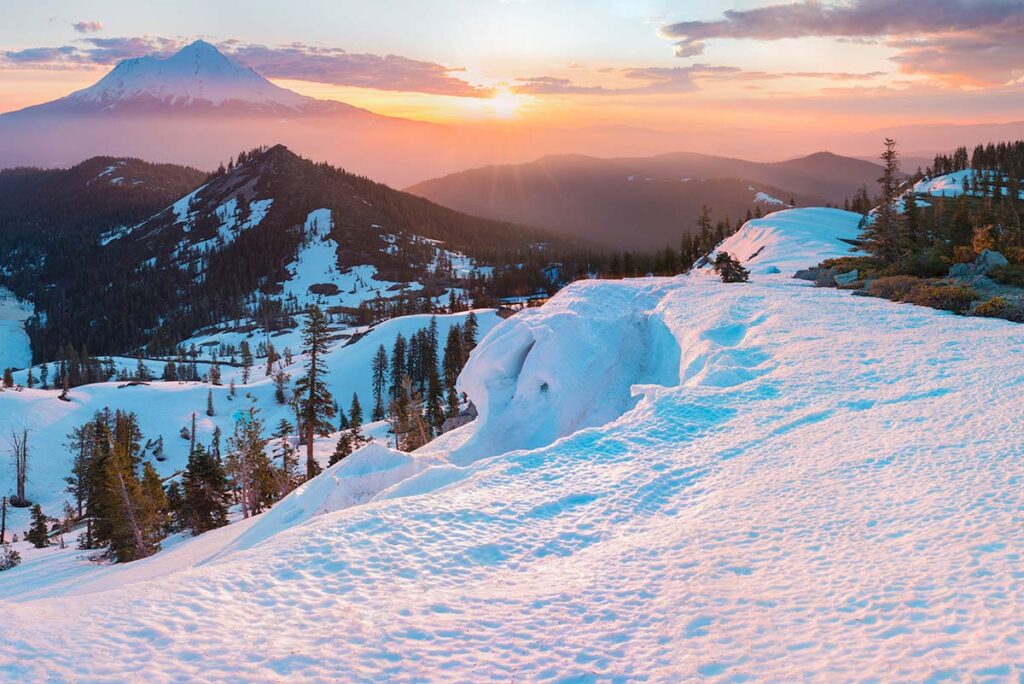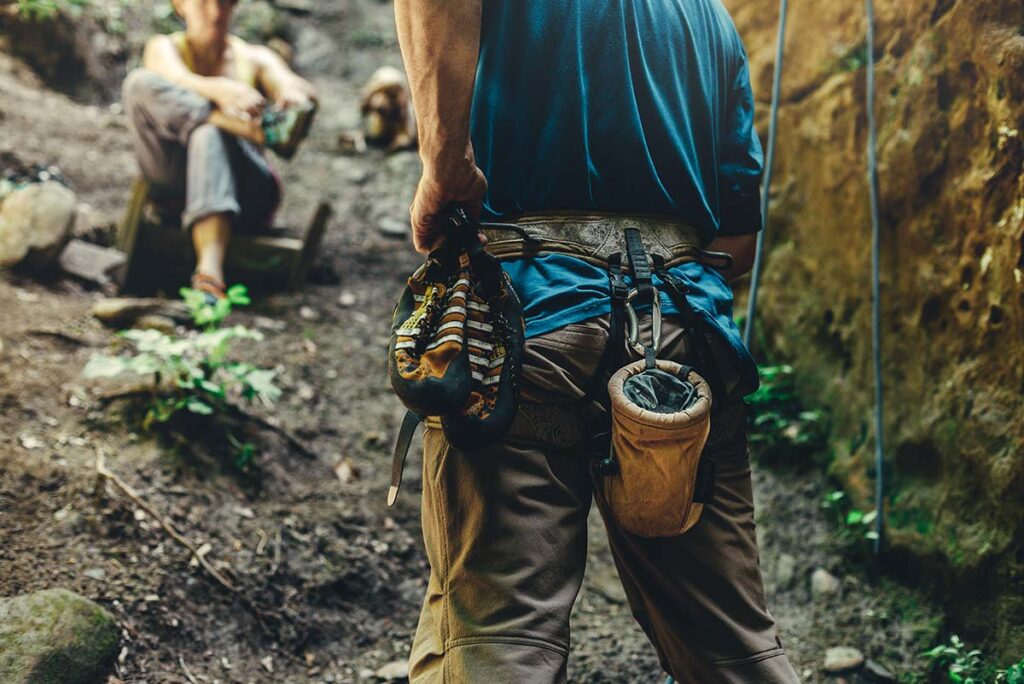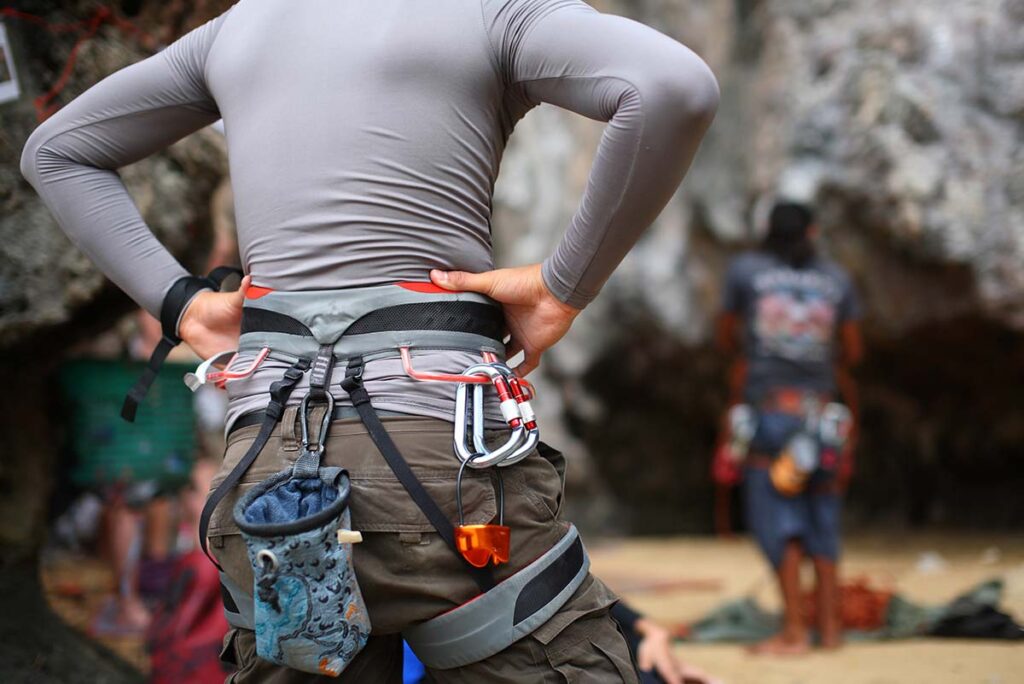Introduction to Mount Shasta
High up in the Northern California skies, where the world seems to touch the heavens, stands Mount Shasta. It isn’t just a mountain; it’s a narrative carved by time, a symbol of spiritual quests, a challenge for modern adventurers, and an ever-present guardian for those who live in its shadow.
Imagine waking up on a crisp morning, where the air is so clear you feel you could almost drink it. As the golden hues of dawn caress the horizon, there’s a silhouette that stands taller, grander, and more majestic than anything in its vicinity. That’s Mount Shasta for you, a natural marvel with an enigmatic aura that has been inspiring poets, luring explorers, and captivating the hearts of many.
To simply classify Mount Shasta as a geological wonder would be an understatement. This magnificent peak has a story that’s as multifaceted as its slopes. A story that intertwines myth with reality, ancient civilizations with present-day communities, and the ethereal with the tangible.
But what is it about this particular peak that makes it so enchanting? Is it its towering presence, visible from miles away, beckoning travelers like an old friend? Or is it the legends that whisper through the winds, stories of ancient guardians and hidden cities? Maybe it’s the challenge it presents, promising glory to those who can conquer its heights.
Whatever the draw, one thing is certain: Mount Shasta isn’t just a mountain. It’s an experience, a journey, and a testament to nature’s grandeur. As we delve deeper into this guide, let’s embark on a journey together — to discover, understand, and appreciate the myriad wonders of this timeless sentinel.
Mt. Shasta Geographical Overview
Location and Topography:
Mount Shasta is located in Siskiyou County, approximately 60 miles north of Redding, California. Dominating the surrounding landscape, the mountain rises majestically to an elevation of 14,179 feet (4,322 meters), making it the fifth highest peak in California. The mountain itself is part of the larger Cascade Range which stretches from Northern California into Canada.
Mount Shasta is not a single peak but a complex of overlapping cones, presenting a multifaceted topography that includes vast glaciers, deep valleys, and lush meadows. Despite its massive size, Shasta stands somewhat isolated, which further emphasizes its grandeur and prominence in the landscape.
Volcanic History and Geology:
Mount Shasta is a stratovolcano, characterized by its large size and steep profile. Its geologic history is a tale of explosive eruptions and gradual build-up over hundreds of thousands of years.
The mountain’s volcanic activity dates back to over 590,000 years ago. Over time, eruptions from different cones have layered the mountain in a rich tapestry of andesite and basalt flows, pyroclastic debris, and mudflows. Its most recent significant eruption is believed to have occurred around 200 years ago, but minor eruptions and steam releases have been documented in more recent history.
Four overlapping volcanic cones comprise the overall structure of Mount Shasta. While the now-eroded remnants of the oldest cone, the Sargents Ridge, date back nearly 300,000 years, the youngest, the Shastina cone, is a mere 9,500 years old.
Geologists keep a watchful eye on Mount Shasta due to its potential to erupt again. Although dormant, its prominence and past activity make it a subject of continuous study.
Mt. Shasta’s Cultural and Historical Significance
Native American Heritage:
Long before hikers and climbers set their sights on Mount Shasta’s snowy peaks, Native American tribes revered the mountain as sacred ground. Tribes such as the Shasta, Modoc, Atsugewi, and Wintu have deep-rooted connections to the mountain, viewing it as a spiritual center and a place of great power.
For these indigenous communities, Mount Shasta has been a site for ceremonies, myths, and legends. Tales of spirits, hidden cities within the mountain, and powerful beings are woven into the oral traditions of these tribes. To this day, members of these communities continue to perform rituals and seek spiritual enlightenment on the mountain’s slopes.
Early Explorers and Climbing History:
The allure of Mount Shasta was not confined to the indigenous peoples. European-American explorers in the 19th century were drawn to its imposing figure, with the first documented ascent by a European-American taking place in 1854 by Captain E.D. Pearce. However, it’s worth noting that Native Americans had been scaling its heights for centuries before.
By the late 1800s, Mount Shasta had gained popularity among recreational climbers, leading to the establishment of the Sierra Club’s Shasta Alpine Lodge in 1922. The mountain’s accessibility and diverse routes made it a favored destination for both novice hikers and seasoned mountaineers.
Over the years, many tales of adventure, tragedy, and triumph have been tied to Mount Shasta. From early expeditions facing unpredictable weather to modern climbers pushing the limits of endurance, the mountain has seen it all, further cementing its status as a beacon for those seeking challenge and beauty in equal measure.

Preparing for Your Hike
Every great adventure begins with meticulous preparation. Hiking Mount Shasta is no different. Whether you’re a seasoned mountaineer or a beginner eager to challenge yourself, the key to a memorable and safe journey up this legendary peak lies in the details. From deciding the optimal time for the ascent to ensuring your backpack contains all essentials, preparation is more than just a pre-hike task—it’s the foundation of your entire experience.
When to Go
Mount Shasta’s allure is year-round, but not all seasons are created equal when it comes to making the ascent.
Best seasons for hiking: Late spring to early summer (May to July) is arguably the prime window for hiking Mount Shasta. The snow from winter starts to melt, opening up popular routes and making the trails more accessible. However, for those seeking a winter adventure, guided snowshoe or ski tours can be an exhilarating option, though they come with their own set of challenges and risks.
Weather patterns and conditions: While summer promises warmer temperatures and blooming alpine flowers, the mountain’s weather is notoriously unpredictable. Sudden storms, temperature drops, and high winds can occur even in the sunniest months. It’s essential to frequently check weather forecasts leading up to your hike and prepare for a range of conditions.
Essential Gear and Packing List
Every ounce counts when you’re trekking up a mountain, and the last thing you want is an over-packed bag or, worse, forgetting something crucial. Here’s a comprehensive checklist to ensure you’re well-equipped for the Shasta challenge.
Backpacking checklist:
- Clothing Recommendations
- Base Layers: Moisture-wicking materials keep sweat at bay, ensuring you stay warm and dry.
- Insulation: Lightweight down jackets or fleece layers provide warmth without the added weight.
- Outer Layer: Waterproof and windproof jackets shield you from unpredictable weather.
- Footwear: Sturdy hiking boots with ankle support and a solid grip are a must. Don’t forget moisture-wicking socks.
- Accessories: Sun hats, beanies, gloves, and sunglasses are all essential for protection against the elements.
- Food and Hydration
- Snacks: Energy bars, nuts, and dried fruits are lightweight and provide quick energy boosts.
- Meals: Freeze-dried meals are a favorite for their longevity and minimal weight.
- Hydration: Always carry a refillable water bottle or hydration bladder. Consider water purification tablets or a portable filter if relying on natural sources.
- Navigation and Communication Tools
- Map and Compass: While GPS devices are handy, always have a physical map and compass as a backup.
- Personal Locator Beacon (PLB) or Satellite Phone: In areas without cell service, these can be life-saving.
- Emergency and First Aid Items
- First Aid Kit: Tailored for personal needs but should include basics like bandages, antiseptics, pain relievers, and blister treatments.
- Emergency Shelter: A lightweight bivvy or emergency blanket can be vital in unexpected situations.
- Multipurpose Tool or Knife: Useful for repairs, food prep, and emergencies.
Obtaining Permits and Regulations
Your adventure on Mount Shasta isn’t just a personal journey; it’s a shared experience with nature and fellow hikers. To ensure the mountain remains pristine for generations, certain regulations are in place.
Permit application process: Anyone venturing above 10,000 feet or into the wilderness zones on Mount Shasta requires a Summit Pass. They’re available at ranger stations, certain local businesses, or can be purchased online in advance.
Leave No Trace principles: Mount Shasta is more than a hiking destination—it’s a treasure. Adhering to Leave No Trace principles ensures we respect and preserve its beauty. This means packing out everything you bring in, avoiding trampling on delicate vegetation, camping at designated sites, and respecting wildlife and fellow hikers.
Embarking on a journey up Mount Shasta is no small feat. But with the right preparation, not only will you enhance your safety, but you’ll also amplify your enjoyment and connection to this majestic mountain.

Mount Shasta Trail Routes
Scaling Mount Shasta isn’t just about reaching the summit—it’s about the journey. Every trail has its own narrative, from serene meadows bursting with wildflowers to challenging ascents that test one’s mettle. The mountain offers a diverse range of routes, each providing a unique perspective and experience of this majestic peak. Below, we delve into some of the most renowned routes that have beckoned countless hikers over the years.
Bunny Flat to Horse Camp
Route Description: Starting at Bunny Flat, this trail meanders through a verdant forest before giving way to open spaces dotted with firs and pines. As you climb, views of the mountain’s west face become more and more breathtaking. The highlight of this trail is Horse Camp, a historic stone cabin serving as a base for mountaineers. The surrounding meadow, often carpeted with wildflowers, offers respite and a perfect spot for camping.
Difficulty and Elevation Gain: Moderate. This route covers approximately 1.8 miles one-way with an elevation gain of about 1,100 feet. It’s a favorite among beginners and families due to its manageable distance and incline.
Avalanche Gulch
Route Description: Avalanche Gulch is not just the most popular route up Mount Shasta; it’s a rite of passage for many mountaineers. Starting at Bunny Flat, the trail heads to Horse Camp before venturing into the heart of the gulch. This route offers a dynamic landscape, from snowfields and rocky terrains to the impressive Red Banks, a series of red and orange cliffs. The ascent culminates with a final push to Misery Hill, leading to the mountain’s summit.
Difficulty and Elevation Gain: Strenuous. Spanning roughly 11 miles round-trip, hikers should anticipate an elevation gain of around 7,300 feet. This route requires physical fitness, acclimatization, and, depending on the season, proper snow equipment.
Clear Creek Route
Route Description: The Clear Creek Route is celebrated for its relatively non-technical nature and captivating vistas. Beginning at the Clear Creek Trailhead, the path unfolds through a dense forest, ascending steadily. The trail then meanders through Mud Creek Canyon, offering panoramic views of Shasta’s eastern face and the distant landscapes below. The route’s final sections involve navigating scree and talus slopes, but the reward is an unobstructed, awe-inspiring view from the top.
Difficulty and Elevation Gain: Intermediate to Strenuous. The route spans about 12 miles round-trip with an elevation gain of approximately 7,900 feet. While less technical than Avalanche Gulch, hikers should still be prepared for its considerable length and incline.
Other Hiking Routes
Remember, each trail on Mount Shasta tells its own tale, offering unique challenges and rewards. Your choice might depend on your hiking experience, fitness level, or even the kind of story you want your journey to tell. Whichever route you choose, Shasta promises an unforgettable adventure filled with awe, challenge, and profound beauty.

Safety and Precautions
Conquering a giant like Mount Shasta is a test of endurance, will, and skill. But, just as importantly, it’s a test of preparedness. No matter how many peaks one might have summited or trails tread, nature remains unpredictable. Your respect for the mountain, coupled with awareness and preparation for its challenges, will ensure not only a successful ascent but also a safe return.
Altitude Sickness: Prevention and Treatment
At higher elevations, the air becomes thinner, meaning fewer oxygen molecules are available with each breath. This can lead to altitude sickness, which, if left untreated, can be severe.
Prevention:
- Acclimatization: Gradually increase your altitude over several days. If possible, spend a night or two at a high-altitude location before your ascent.
- Stay Hydrated: Dehydration can exacerbate altitude sickness. Drink plenty of water.
- Avoid Alcohol and Tobacco: Both can worsen altitude sickness.
- Eat Carbs: Your body digests them more easily at higher altitudes.
Treatment: If you experience symptoms like headache, dizziness, nausea, or shortness of breath, it’s crucial to:
- Descend: Even a small descent can make a huge difference.
- Stay Hydrated and Rest: Give your body time to adjust.
- Seek Medical Attention: If symptoms are severe or persistent.
Wildlife Encounters
Mount Shasta’s pristine wilderness is home to various animals, from the majestic to the elusive.
Local Wildlife Overview: Deer, black bears, mountain lions, and a plethora of bird species call Shasta home. While the chance of an encounter is part of the mountain’s allure, it’s essential to be prepared and knowledgeable.
Tips to Prevent Negative Interactions:
- Store Food Properly: Use bear-proof containers and hang food away from your campsite.
- Stay Aware: Make noise while hiking to avoid startling animals.
- Keep Distance: If you encounter wildlife, appreciate from a distance. Never approach or feed them.
- Travel in Groups: There’s safety in numbers.
Weather and Environmental Hazards
The weather on Mount Shasta can change in an instant, going from clear skies to a raging storm.
Recognizing and Responding to Signs of Storms:
- Cloud Formations: Rapidly forming clouds or a halo around the sun/moon can indicate a storm.
- Temperature Drop: A sudden drop can precede a storm.
- Seek Shelter: If you notice signs, it’s best to descend or find a safe spot.
- Stay Updated: Check weather forecasts regularly.
Avalanches and Glacier Travel Precautions:
- Educate Yourself: Understand the basics of avalanches, like recognizing potential avalanche terrains.
- Equipment: Always carry avalanche safety gear, including a beacon, shovel, and probe.
- Travel Early: Snow is more stable in the early morning.
- Stay Alert: Watch for signs like cracks or a “whumping” sound, which can indicate unstable snow.
Mount Shasta offers a realm of wonder and beauty, but it demands respect. Equip yourself with knowledge, stay aware, and always prioritize safety. The mountain will reward you with memories that will last a lifetime.

Sustainable Hiking Practices
As the allure of Mount Shasta draws adventurers from near and far, the responsibility to tread lightly and respectfully becomes paramount. A sustainable approach to hiking ensures that we can continue to enjoy the mountain’s majesty for generations to come. Here, we delve into practices that foster a deep respect for the environment and the communities nestled in the shadow of this iconic peak.
Minimizing Human Impact on the Mountain
The fragile ecosystems of Mount Shasta are a testament to nature’s delicate balance. As visitors, it’s crucial to ensure our presence doesn’t disturb this harmony.
Sticking to Trails: Wandering off the designated paths can trample delicate flora, lead to soil erosion, and disturb wildlife habitats. Always stay on marked trails. Not only does this protect the environment, but it also ensures your safety.
Proper Waste Disposal: “Pack it in, pack it out” is more than a mantra—it’s a commitment. Whether it’s food wrappers or biodegradable items like fruit peels, ensure you carry them out with you. For human waste, utilize established facilities or bring a portable toilet. Remember, leaving no trace isn’t just an ethic; it’s a promise to the mountain.
Supporting Our Local Communities
The communities surrounding Mount Shasta are gatekeepers to its stories, history, and traditions. They play an invaluable role in preserving the mountain’s essence. In turn, our support nourishes these communities, ensuring they thrive.
Shopping Local: Before embarking on your hike, consider purchasing supplies, equipment, or even souvenirs from local stores. This not only boosts the local economy but also introduces you to authentic, region-specific goods and produces.
Hiring Local Guides: If you’re considering hiring a guide, opt for local experts. They possess an intimate knowledge of the mountain’s trails, folklore, and nuances. Plus, your funds directly benefit the community and foster a sustainable tourism model.
Mount Shasta isn’t just a hiking destination—it’s a living entity with deep roots in local culture and ecology. Every step we take, both literally and figuratively, should echo our respect and gratitude. By embracing sustainable practices, we don’t just leave a mountain unchanged; we leave a legacy of stewardship for the adventurers who follow in our footsteps.
Additional Resources and Information
After a comprehensive exploration of hiking on Mount Shasta, it’s also worth noting the myriad of resources and additional experiences that enhance your journey. From comfortable places to rest your head to thrilling activities that complement your hike, Mount Shasta brims with opportunities. This section is dedicated to ensuring you make the most of your time, turning your expedition into a holistic adventure.
Nearby Accommodations and Facilities
Ensuring a pleasant stay is vital to recharge before or after your hike. Here’s a glimpse into the offerings around Mount Shasta:
- Hotels and Lodges: There’s a range of options, from luxury lodges with panoramic mountain views to cozy, budget-friendly hotels.
- Bed and Breakfasts: For those seeking a more intimate experience, various B&Bs around the mountain provide a homey touch.
- Campsites: For the purists wishing to be one with nature, numerous campsites, both regulated and wild, allow for starry nights under the Shasta sky.
- Facilities: Many areas, especially near popular trailheads, offer facilities such as restrooms, potable water sources, and informational kiosks.
Guided Hiking Tours and Training Programs
If you’re looking to enrich your Mount Shasta experience or if you’re a novice eager to learn:
- Mountaineering Schools: Several institutions offer courses in mountaineering, focusing on skill-building, safety, and technical aspects of mountain climbing.
- Guided Hikes: Whether you’re aiming for the summit or just a scenic trail, local guides can provide insightful tours, sharing the mountain’s secrets and lore.
- Cultural and Historical Tours: Dive deeper into the rich history of Mount Shasta by joining guided tours that highlight its cultural and historical significance.
Other Outdoor Activities Around Mount Shasta
While hiking is a marquee attraction, Mount Shasta boasts a spectrum of recreational activities:
- Camping: The mountain’s foothills and surrounding forests offer idyllic spots for camping, where you can be lulled to sleep by the whispers of nature.
- Skiing: In winter, parts of Shasta transform into a skiing paradise, with opportunities for both downhill and cross-country skiing.
- Fishing and Boating: The alpine lakes and rivers near Mount Shasta are ideal for fishing and offer serene settings for canoeing and kayaking.
- Stargazing: With minimal light pollution, the skies above Mount Shasta come alive at night, making it a haven for astronomers and romantics alike.
Whether you’re here for the challenge of the ascent, the tranquility of nature, or the rich tapestry of experiences that the mountain offers, there’s a wealth of resources available to make your journey memorable. Take the time to explore, indulge, and immerse yourself in all that Mount Shasta has to offer.

Conclusion and Parting Thoughts
Mount Shasta, with its towering presence and sweeping landscapes, is more than just a geographical marvel—it’s a testament to the enduring spirit of nature and the adventurous soul within us all. The paths that zigzag across its terrain take us on journeys of not only physical endurance but also personal introspection. Each step upwards offers a lesson, each panoramic view a reward, and each descent a reflection of the accomplishments of the day.
For those who have been graced by the mountain’s majesty, there’s a profound understanding that the experience is about more than the hike itself. It’s about connecting with a place, with its history, its challenges, and its ever-changing moods. It’s about the stories shared along the way, the challenges faced, and the memories forged.
Whether Mount Shasta is a one-time adventure for you or a place you find yourself returning to time and time again, the mountain leaves an indelible mark. It beckons, inspires, and reminds us of the wonders that await when we step outside our comfort zones and embrace the wild, unpredictable, and beautiful world around us.
Our environment and community here in Shasta it’s a celebration of nature, history, culture, and personal endurance. Every trail carved into the mountain’s sides tells a story. Every view from its peak offers a lesson. And every encounter, whether with wildlife or the elements, brings about immense levels of personal introspection. As you reminisce on the mountain’s splendors, consider how deeply intertwined this experience is with the communities and landscapes that nestle at its feet.
For many, a single visit to Mount Shasta ignites a lifelong connection. The idea of owning a piece of this paradise, be it a primary residence or a weekend getaway, is an aspiration that can bring you closer to the mountain’s spirit every day. Just imagine waking up to the sight of Shasta’s snowy peaks, or unwinding after a hike in your cozy home, with the mountain as your backdrop. If this vision resonates with you, remember we here at Serene Shasta would love to welcome you to our community and are ready to guide you in turning that dream into a reality. Our roots in the region and our love for the mountain ensure you find not just a house, but a home here.
May your memories of Mount Shasta be as enduring as the mountain itself, serving as a beacon for future adventures and a reminder of the power of nature and the human spirit.
Do you have any experience or stories hiking up Mount Shasta? Maybe you have some hidden trails or advice? We’d love to hear from you in the comments below!
- The 1031 Exchange: The Secret Weapon of Real Estate Wealth - January 29, 2024
- What’s Up with the California Housing Market in 2024? - January 27, 2024
- What Is Escrow? Everything You Need To Know - January 27, 2024






